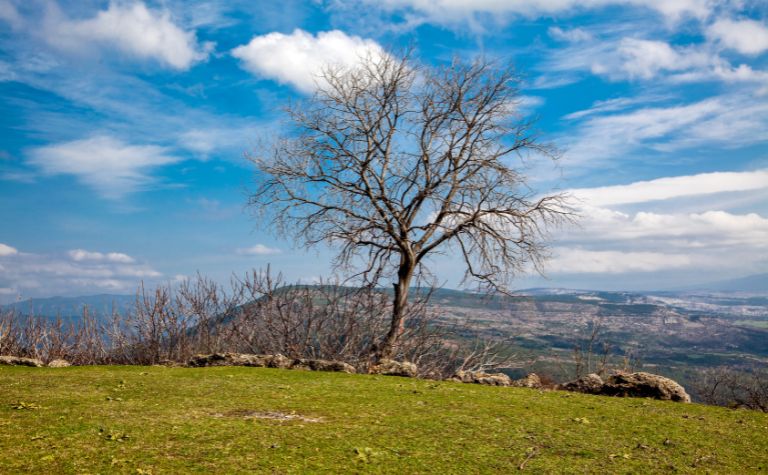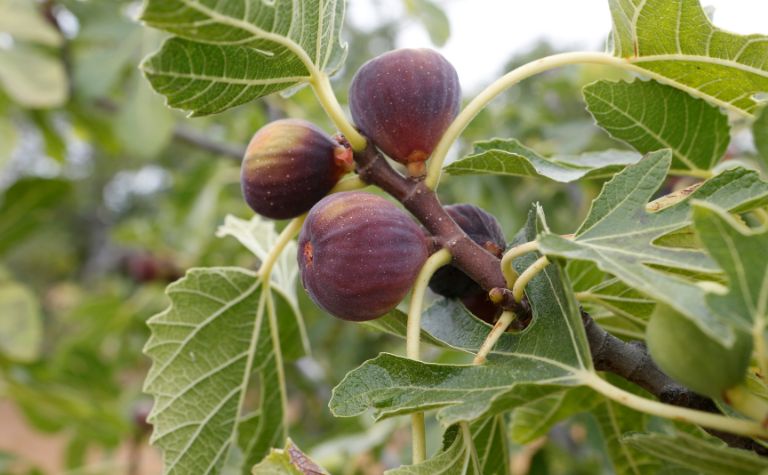During the last week of Jesus’ life, his disciples overheard him speak to a fig tree. The unexpected moment occurred the day after he entered Jerusalem riding a donkey, and the same day he overturned the tables in the temple. Yet, Jesus didn’t merely speak to the tree. He cursed it. But why?
Jesus cursed the fig tree as an object lesson for the disciples, revealing to them the consequences of Israel’s spiritual fruitlessness. Fig trees represent the nation in the Old Testament. So when Jesus found one with only leaves on its branches, he used it as a visual aid and condemned its barrenness.
Why did Jesus yell at a fig tree? Why did he curse it for not having fruit when it was out of season? As some critics suggest, did Jesus lose his temper because he was hungry? Why is the story sandwiched between Jesus’ clearing of the temple? What is the application of this story for Christians today? Keep reading to learn the answers to these questions and others.
Also, see How Many Brothers Did Jesus Have? to learn more.

Christians and Non-Christians Question the Curse
Jesus’ cursing of the fig tree has caused faithful believers and faithless skeptics to question its purpose. On the one hand, Jesus’ cursing of the tree makes devoted Bible readers and Christian scholars want to understand its importance for the benefit of the Church and to apply its meaning to their lives.
What did Jesus want his disciples, who observed him curse the tree, to take away from the story? Why is the timing of the scene, which occurred during the last week of his pre-resurrection life, important?
On the other hand, critics of Jesus have used the story to dismiss the Christian faith. The atheist Bertrand Russell cites this story in his book, Why I am Not a Christian. The 19th-century English scholar, T.W. Manson, argued that Jesus lost his temper and wasted his power on a poor fig tree.
Jesus was looking for food to eat
The last week of Jesus’ life, sometimes called “Passion Week,” is filled with extraordinary events. It’s such an important time in Jesus’ life that each Gospel devotes significant space to it. For example, Mark devotes one-third of his Gospel (Ch. 11-16) to the seven-day period, which includes the story of the fig tree.
Mark mentions Jesus’ hunger to set the scene. “On the following day, when they came from Bethany, [Jesus] was hungry” (Mark 11:12, ESV). The following day refers to the second day of Passion Week, i.e., the last Monday before Jesus’ crucifixion. The day before, he entered Jerusalem on a donkey like a king (Mark 11:1-10).
| Day | Event |
|---|---|
| Sunday | The Triumphal Entry (e.g., Matt. 21:1-11) |
| Monday | Cursing the fig tree; clearing the temple (e.g., Mark 11:12-18) |
| Tuesday | Day of parables and teaching (e.g., Luke 20:1-21:36) |
| Wednesday | Nothing recorded |
| Thursday | Passover and the Last Supper (e.g., Matt. 26:17-30) |
| Friday | Jesus’ crucifixion (e.g., Mark 15:1-47) |
| Saturday | Jesus is in the tomb |
| Sunday | Jesus’ resurrection (e.g., Matt. 28:1-13) |
Also, see Who Walked on Water with Jesus? to learn more.

Jesus rebuked the tree’s barrenness
On Tuesday, Jesus sought food to eat and spotted a fig tree. “And seeing in the distance a fig tree in leaf, he went to see if he could find anything on it. When he came to it, he found nothing but leaves, for it was not the season for figs” (Mark 11:13, ESV). The tree was one to two months from producing fruit. [1]
In response to the tree’s fruitlessness, Jesus sentenced it to permanent barrenness. “And he said to it, ‘May no one ever eat fruit from you again.’ And his disciples heard it” (Mark 11:14). Was Jesus mad at the tree simply because it couldn’t satisfy his hunger? Or is there more to the story?
Bible readers must realize that Mark doesn’t finish the story until later in the chapter because he strategically sandwiches another story between its beginning and end.
- Jesus curses the fig tree (11:12-14)
- Jesus clears the temple (11:15-19)
- The disciples notice the tree is dead (11:20-21)
The disciples noticed the fig tree was dead the next day, on Tuesday morning of Passion Week. “As they passed by in the morning, they saw the fig tree withered away to its roots. And Peter remembered and said to him, ‘Rabbi, look! The fig tree that you cursed has withered'” (Mark 11:20-21).
Miraculously, the tree hasn’t shed leaves due to a change in season or just become sick. Instead, the tree is withered to its roots. It’s dead and can’t be resuscitated.
How does the temple scene explain Jesus’ cursing of the tree? The withered fig tree is directly connected to Jesus’ outburst in the temple. The stories occur on the same day during Passion Week, and Mark’s narrative brilliantly interweaves the events to demonstrate that they are related to each other. Keep reading to learn how the stories relate to each other.
Also, see What Is Discipleship in the Bible? to learn more.

The Fig Tree Is a Symbol of Israel
Jesus isn’t angry at the tree. Instead, he’s seizing a teaching moment to reveal the consequences of Israel’s fruitlessness to the disciples. The tree symbolized Israel, as it did in several passages in the Old Testament, and its barrenness represented what had become of the nation under its faithless and legalistic leaders.
| Verse | Israel Like a Fig Tree |
|---|---|
| Jer. 24:5 | “Thus says the Lord, the God of Israel: Like these good figs, so I will regard as good the exiles from Judah, whom I have sent away from this place to the land of the Chaldeans.” |
| Jer. 29:17 | “Thus says the Lord of hosts, behold, I am sending on them sword, famine, and pestilence, and I will make them like vile figs that are so rotten they cannot be eaten.” |
| Hosea 9:10a | “Like grapes in the wilderness, I found Israel. Like the first fruit on the fig tree in its first season, I saw your fathers.” |
| Also see | Isa. 28:4; Jer. 8:13, 29:17; Hos. 2:12, 9:10, 9:16-17; Mic. 7:1 |
Individual Israelites, like Paul, could believe in Jesus as the Messiah, follow him as a disciple, and bear fruit, but the nation’s role changed forever.
The tree and the temple
Some Bible scholars teach that the tree represents the nation of Israel. Others suggest it specifically represents the temple. Yet others argue that both ideas are included in the story.
Mark scholar, David Garland, writes, “The fig tree incident brackets the temple action and interprets it. It reveals more clearly that Jesus does not intend to cleanse the temple. Instead, his actions visually announce its disqualification. The fig tree that has not borne fruit is cursed, not reformed or cleansed.” [2]
| Tree | Temple |
|---|---|
| Represents Israel | Represents Israel |
| Jesus finds it physically barren | Jesus finds it spiritually barren |
| Jesus disables its future production | Jesus disables its future production |
Garland elaborates on the parallels between the fig tree and the temple. “As the fig tree’s time is barren (cf. Luke 13:6-9), so is the temple’s. Time can run out for fruitless trees and prayerless temples. Fruitlessness now when the Messiah has come means fruitlessness forever.” [2]
Applying the story of the fig tree
The New Testament instructs followers of Jesus to bear fruit. For example,
- Galatians 5:22-23, “But the fruit of the Spirit is love, joy, peace, patience, kindness, goodness, faithfulness, gentleness, self-control; against such things there is no law.”
- John 15:4, “Abide in me, and I in you. As the branch cannot bear fruit by itself, unless it abides in the vine, neither can you, unless you abide in me.”
- Matthew 3:8, “Bear fruit in keeping with repentance.”
Strauss writes, “The responsibility to bear fruit has direct application to the church today… The fruit that we bear represents the impact we have on others for the kingdom of God. This can refer to bringing others to Christ, the fruit of new birth in Christ, as well as our behavior that has a positive impact on others for the sake of the kingdom.” [3]
Also, see How Old Was Jesus When He Was Baptized? to learn more.
References:
[1] Mark by Mark Strauss. ZECNT. p. 491.
[2] Mark by David Garland. NIVAC. p. 439.
[3] Strauss. p. 501.
Related Questions
A lot of people know that Jesus of Nazareth lived a long time ago. They may even know that he was a Jewish man born at the time of the Roman Empire. Yet, they are unclear about exactly when he was on...
Regular Bible reading is a valuable habit, as Scripture is God's message to people. However, the Bible's 66 distinct books, featuring various authors, settings, and themes, can make it challenging...
